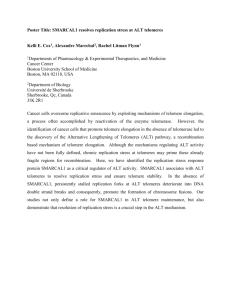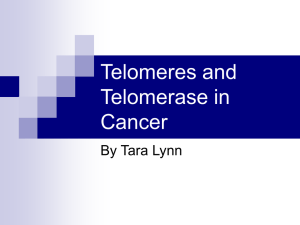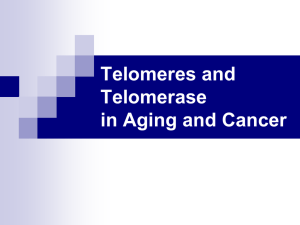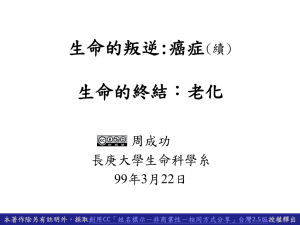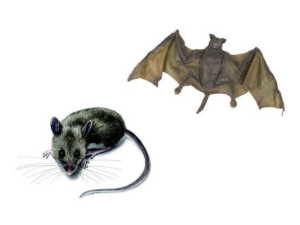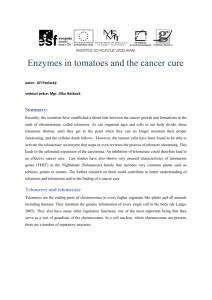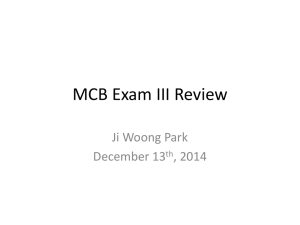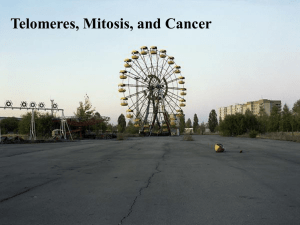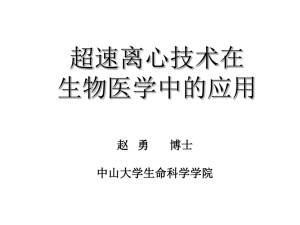Lec 7.
advertisement
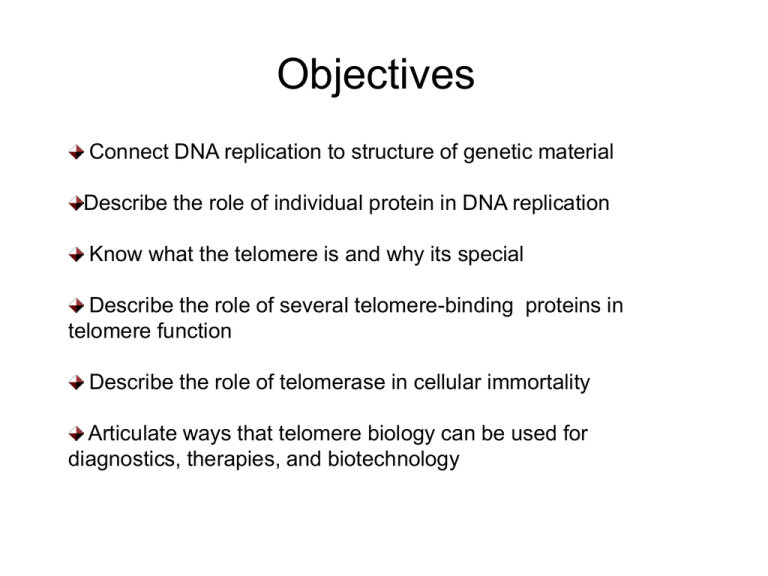
Objectives Connect DNA replication to structure of genetic material Describe the role of individual protein in DNA replication Know what the telomere is and why its special Describe the role of several telomere-binding proteins in telomere function Describe the role of telomerase in cellular immortality Articulate ways that telomere biology can be used for diagnostics, therapies, and biotechnology Importance of DNA Replication • DNA must be replicated every time a cell divides – Errors in replication can cause mutation, thus replication must be accurate; fidelity – Eukaroytic genomes are large, therefore replication must be fast and efficient • Replication takes advantage of the “instructive” aspect of base-pairing in DNA synthesis – incorporation of nucleotide only occurs if proper Watson-Crick base pairs can be made Replication is Semi-Conservative Much is Conserved in DNA Replication Direction Template Primer DNA Replication Steps Initiation: Assembly of a replication fork (bubble) Fork is generated primosome Elongation: Addition of bases Catalyzed by the replisome. Parental strands unwind and daughter strands are synthesized Termination: Duplicated chromosomes are separated The Replication Fork Initiation: Work of the Primosome At origins of replication the primosome goes to work Helicase Separates the DNA Strands Single-strand DNA binding proteins Bind strands in this region as single-stranded Primase Makes the primers Helicase Unwinds DNA to present template Unwinding at the fork supercoils DNA in advance of the fort Topoisomerase relaxes supercoil (ATP dependent) Initiation: Isolate Template; Make Primer ssDNA-Binding proteins keep template single stranded Primase makes an RNA primer Elongation: The Work of DNA Polymerase Chemical Mechanism of Nucleotide Addition Elongation: Rolling Circle Two polymerase moving in opposite directions Leading and Lagging Synthesis are Coupled http://www.youtube.com/watch?v=5VefaI0LrgE&feature=related Semi-Discontinuous Synthesis and Primer Removal Priming leading strand Leading strand synthesis Priming lagging strand Primers removed Okazaki fragment synthesis Resulting DNA fragments joined Okazaki fragment synthesis How Can Polymerase Copy The Whole Chromosome in a Few Hours? Normal DNA Replication Fails to Replicate the Telomere How to Overcome the End-Replication Problem Nosek, J.; Kosa, P.; Tomaska, L.BioEssays (2006) 28:182–190 The Telomere is the Chromosome Aglet FISH analysis of healthy chromosomes FISH analysis of chromosomes with short telomeres FISH analysis of damaged chromosomes Telomeres can be visualized Telomeres signal is decreased Chromosomes are fused and damaged The Chromosome End 3’ Overhang ...TTAGGGTTAGGGTTAGGGTTAGGGTTAGGGTTAGGG-3’ ...AATCCCAATCCCAATC-5’ Telomeric DNA, TTAGGG in humans Double stranded region is 5,000 to 20,000 bases Single strand region is 150-300 bases Human Chromosome The Chromosome Ends in a Loop 5’ 5’ 5’ 3’ 3’ 3’ Griffith, J.D. et al. Cell 1999, 97, 503-14. The Chromosome Ends in a Loop 5’ 5’ 5’ 3’ Electron micrograph of a telomere 3’ 3’ Griffith, J.D. et al. Cell 1999 The Telomere is a Protein-DNA Complex 5’ 3’ POT1 5’ 3’ TIN2 TRF1 5’ TPP1 TRF2 RAP1 3’ de Lange Genes Dev. 2005 The Telomere is a Protein-DNA Complex 5’ 5’ 5’ 3’ 5’ 5’ 5’ 3’ POT1 TPP1 TIN2 TRF1 3’ TRF2 RAP1 3’ 3’ 3’ The Telomere is a Protein-DNA Complex 5’ 5’ 5’ 3’ 3’ 3’ Nikitina and Woodcock J. Cell. Biol. 2004 5’ 5’ 5’ 3’ 3’ 3’ Normal DNA Replication Fails to Replicate the Telomere Telomerase is a Ribonucleoprotein Complex Ciliate telomerase Human telomerase TERT hTERT Template Dyskerin p43 (p65) ´ Template Common features of all telomerase complexes: RNA supplies the template TERT is the catalytic subunit RNA-binding protein is present The Telomere is the Chromosome Aglet FISH analysis of healthy chromosomes FISH analysis of chromosomes with short telomeres FISH analysis of damaged chromosomes Telomeres can be visualized Telomeres signal is decreased Chromosomes are fused and damaged Telomere Length Determines Cellular Longevity Time/cell divisions Why Have Linear Chromosomes Anyway? Meioses with a Circular Chromosome. Ishikawa, F; Naito T. Mutation Research 434 1999. 99–107 Why Have Linear Chromosomes Anyway? Telomere Maintenance and Human Health Normal aging, stress, and the environment can all reduce telomere length Stem cells senescence wound healing rate decreases tissue regeneration ability decreases Aging disorders: deficiencies in telomere maintenance Mutations in hTR, hTERT and DKC1 gene Haplodefeciency in telomerase activity Telomere Maintenance and Human Health Cancer and telomere maintenance Cancer cells require proper telomere maintenance Telomerase positive (85%), ALT (15%) Telomere length and telomerase correlations to prognosis Stem cell technology Attempts to maintain cells in culture without senescence Cancer Requirements Normal cell Continuous growth ras Hyperproliferative cell Overcome replicative senescence Rb, p53 Proliferative cell On verge of genetic crisis Maintain telomeres telomerase, ALT Cancer Telomere Length Determines Cellular Longevity Telomerase: Functions Away From the Telomere Inhibits apoptosis Increases tumorigenicity Promotes proliferation Promotes healing Promotes hair growth (in mice) Therapeutic Approaches Direct telomerase inhibition as anti-cancer modality Delayed effect In situ generation of a dominant negative complex Unknown effects Combination therapy: Telomerase and another target Maybe useful for preventing remission and metastasis Immunotherapy using anti-TERT antibodies: phase II clinical Anticancer therapy by changing telomere sequence: Instantaneous effect, but is it plausible? Diagnostics and prognosis testing: TERT expression related to cancer progression GRN163L Enters the Clinic 5’-Palm-TAGGGTTAGACAA-NH2 Palm = Palmitoyl NPS GRN163L Inhibits Telomerase, Telomere Synthesis, and Cell Growth GRN163L Inhibits Tumor Growth Enzyme Inhibitors COOH H N O BIBR1532, from Boehringer Ingelheim N O NH2 N PPO N3 N N Lavelle et al. Crit Rev Onc/Hem 2000, 34, 111-126 Inhibition of Telomerase Causes Telomere Shortening, which can be Reversed Shortening upon treatment COOH H N O BIBR1532, from Boehringer Ingelheim Damm et al. EMBO J 2001, 20, 6958-6968; Pascolo et al. J. Biol. Chem. 2002, Inhibition of Telomerase Causes Telomere Shortening, which can be Reversed Shortening upon treatment Halting treatment: regain telomeres COOH H N O BIBR1532, from Boehringer Ingelheim Damm et al. EMBO J 2001, 20, 6958-6968; Pascolo et al. J. Biol. Chem. 2002, Combination Therapy
